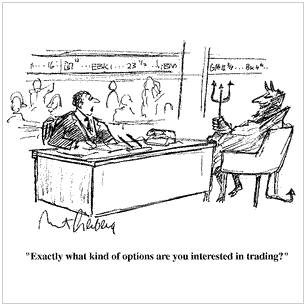Condor Options discusses LEAPs, calls, and options in buying options. – Ilene
– Ilene
Look Before You Buy LEAPS
Courtesy of Condor Options
Long-term Equity Anticipation Securities (LEAPS) are a class of options with expiration dates longer than a year. Their purpose is to allow investors who would otherwise hold shares of an underlying equity to buy an option instead, and thereby participate in expected price movement without tying up as much capital. However, we caution investors against using LEAPS as stock substitutes without first taking volatility considerations into account.
 Let’s say you want to buy 1000 shares of Cisco Systems (CSCO). At $15.91, you’ll tie up $15,910 to hold those shares. If you were comfortable trading LEAPS, you could instead buy 10 January 2010 CSCO 12.50 calls for $4.85, tying up just $4,850 to own those options. You’ll participate in most of the upside should the stock rally over the next year: if CSCO is at $23 by January 2010 expiration, you will have gained $7,020 on the stock position, or about $6,000 on your LEAPS (at .77 delta, the calls will mimic about three fourths the movement of the stock). And as with any long call, your losses are limited to the premium paid – in this case, owning the LEAPS would reduce your exposure by $11,060 should the stock collapse. Of course, if you wanted the option position to track stock movement more closely, you could choose a contract further in the money with higher delta, though the usefulness of the LEAPS as a capital-freeing stock replacement would decrease accordingly.
Let’s say you want to buy 1000 shares of Cisco Systems (CSCO). At $15.91, you’ll tie up $15,910 to hold those shares. If you were comfortable trading LEAPS, you could instead buy 10 January 2010 CSCO 12.50 calls for $4.85, tying up just $4,850 to own those options. You’ll participate in most of the upside should the stock rally over the next year: if CSCO is at $23 by January 2010 expiration, you will have gained $7,020 on the stock position, or about $6,000 on your LEAPS (at .77 delta, the calls will mimic about three fourths the movement of the stock). And as with any long call, your losses are limited to the premium paid – in this case, owning the LEAPS would reduce your exposure by $11,060 should the stock collapse. Of course, if you wanted the option position to track stock movement more closely, you could choose a contract further in the money with higher delta, though the usefulness of the LEAPS as a capital-freeing stock replacement would decrease accordingly.
But delta isn’t the only greek worth attending to when it comes to LEAPS. Those January 2010 calls also carry a vega of .04, which means the option will lose four cents in value for every 1% decline in implied volatility. The current implied volatility in this series is about 53%, which, like most stocks these days, is well below the recent highs but is still historically quite rich. That means anyone buying LEAP calls today may be setting themselves up to lose either way on the volatility front: if the stock rallies, the consequent decline in implied volatility will punish call holders, and at these levels a steady decline will have already been priced into the options, such that a gradual selloff will also be consistent with declining volatility levels.  Either way, traders paying up for premium could lose out relative to those holding shares.
Either way, traders paying up for premium could lose out relative to those holding shares.
Options Are Not On Sale
As a matter of fact, a scan across a number of equities suggests that this may be one of the worst times in recent history to pay up for long-dated call options. Again: a sharp rally in the near term would suck the volatility premium out of the contracts purchased, while the downside ranges assumed in many option prices are unrealistic, causing investors to pay for protection they won’t need. In our CSCO example, the Jan 2010 calls are priced assuming a 43% chance that the stock will be somewhere between its current price ($15.91) and $9 by expiration. While there are undoubtedly some stocks that still have a further 40% decline in their immediate future, unless you think that most stocks will share this fate, buying long-dated calls looks like an especially expensive proposition right now.
But our larger point is that LEAPS are always a little more expensive than they might appear, because more of the premium is attributable to implied volatility than is the case with shorter term options. One of the ways investors attempt to offset this cost is by selling short term out of the money options against their longer dated holdings. In our example, you could sell the April 18 calls for $0.13, and keep the premium assuming the stock is below that level 27 days from now. But this is hardly a solution to the problem of overpaying for the LEAPS: the options being sold have an implied volatility of 41%, not 53%, and with a vega of .01 are much less sensitive to changes in implied volatility. So the bulk of the volatility exposure remains; and while savvy options traders may be comfortable with or even amenable to risks associated with volatility, this is clearly not an area that most stock investors are prepared to navigate. In other words, investors using LEAPS strictly for stock replacement purposes are getting more (and paying for more) than they may have bargained for.
As an alternative to buying LEAPS, we suggest looking at series three or four months out when purchasing calls: while some volatility exposure remains, it is less significant, and rolling the long contracts forward every month or so will prevent time decay from having too much of an impact.


